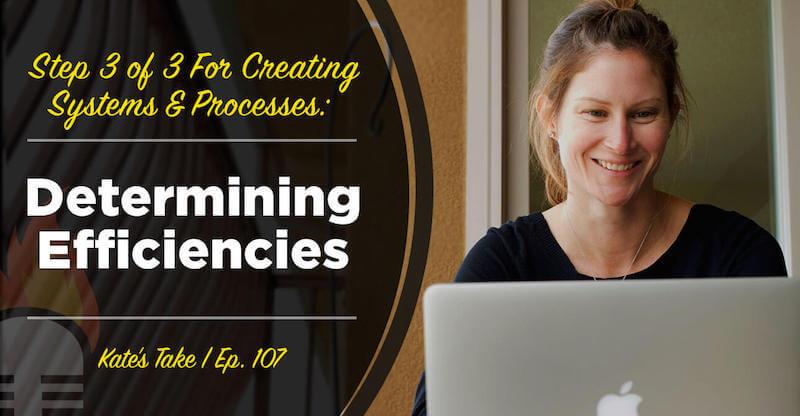
The first two steps for creating systems and processes in your business that will help you scale and grow (and therefore, create freedom) are: 1. Taking inventory and 2. Writing out the steps.
Step 3 of 3 for creating systems and processes in your business: Determining efficiencies
Once you’ve taken inventory, you should have a clear picture of the types of tasks that help your business run and that you probably work on regularly. Once you’ve written out the steps to ONE of the tasks from your inventory, you’ll have a complete list of everything you do every time that task comes up.
This is where it gets fun (and real): Now, it’s time to determine efficiencies for every step within each of the processes you want to create.
Welcome to Step 3 for creating systems and processes in your business!
Step 3: Determining efficiencies
In Step 1 and Step 2 you listened in on a conversation I was having with one of my accountability partners, and that conversation didn’t stop at Step 2. The next thing she asked once we got to Step 3?
“Okay – now that I have my steps written out… how exactly is this saving me time?”
That’s what Step 3 is made for: figuring out how you can start saving yourself time by choosing one of the following 3 categories for EVERY step on your list.
The 3 categories we have to choose from in order to create a process around a particular task include:
1. Automate
2. Delegate
3. Batch
Depending on the task, you might be able to to choose just 1 of these categories, and apply it to ALL of the steps in your process. Or, you might use a combination of all 3 of these categories. But that’s not the important part, so don’t worry about how often you choose any given category – it’ll be different for each task.
How to determine efficiencies
Now that you’ve chosen just ONE task from your list, and you’ve set aside 30 minutes to pretend you’re about to do that task (so you have a list of all the steps you have to take to complete that task), it’s time to decide which steps can either be automated, (through software or other platforms); delegated to a team member, contractor or business; or needs to be batched, which is typically the case with any step that has to be handled by YOU.
Let’s say we’re looking to make our social media process more efficient.
In Step 3, I’m going to look at each of the steps I wrote down that I go through every time I go to handle our social media.
Here’s what writing out the steps for your social media task might look like:
Each time I go to work on my social media, I need to:
- Start with choosing a platform;
- Then, I’m going to determine the frequency that I’m going to be posting on that platform;
- Next, I need to actually curate and/or create the content I’m going to posting on the social media platform;
- I’m going to actually schedule that content so it goes out when I want it to; and finally,
- I’ll have to engage on that platform in order to build relationships with those who are interested in what I have to share.
Then, ask yourself these questions
“Which of these steps can be automated?“
I know I can definitely automate the scheduling piece, because there are some great social media schedulers out there to help me create content wayyyyy far in advance and it will continue sharing that content for me on repeat over time.
Once platform for this: MeetEdgar.
There are also some other great social media schedulers out there, like HootSuite, IFTTT and Socialoomph.
Then, “which of these steps can be delegated?“
Social media is a powerful tool, and so you really want to be sure that you’re choosing the platform and the frequency based on your knowledge of your audience (or your perfect customer if you don’t have an audience yet).
Another important thing for you to do: know what your audience / perfect customer is looking for from you in your content so that what you put out on social media is helpful, useful and valuable to them.
But once you know these things, you can easily and quickly teach someone else to do it for you: curating and creating content is definitely something that can be delegated, because once you know what type of content you’re going to share that will be most valuable to your audience, someone else can go out and find that content (or create the posts based on your own content) for you.
Finally, “which of these steps can be batched?“
Well, we’re only down to one step left, and lucky for us, we definitely batch it: engagement!
Batching simply means that instead of doing the same task at multiple different times throughout the day, week or month, you’re going to roll it all up into 1 time slot in order to make the biggest impact in the shortest amount of time.
Engagement doesn’t have to happen throughout the day. You don’t have to be on social media ALL the time.
I choose to engage in our private Facebook groups every morning, for no more than 45 minutes (we have 3 communities, so that’s at least 15 minutes each). When I’m focused, I can make a huge impact and answer a lot of questions in this period of time.
If you don’t trust yourself to only spend a set amount of time on any given social media platform, try out an online timer, like E.ggTimer. This works wonders – IF you stick to it!
Every possible process known to man
Because there are A LOT of different tasks and steps that you might be working through here in Step 3, it’s impossible for me to cover them all.
But I can assure you if you’re able to familiarize yourself with the concept of determining efficiencies, you’ll be able to apply it to ANY set of steps in your business that you’re looking to build a process around.
When we determine efficiencies, we’re uncovering the steps we take and the time we waste every single time we perform a particular task.
The example above – on social media – if you were doing all of those steps on your own every single time, you’d probably be spending days working on your social media. …I’m guessing you know exactly what it feels like, because you’re probably doing it all on your own now.
By taking a step back, writing out the steps, and determining efficiencies, we now have the opportunity to put a process in place that takes us out of the equation almost completely (except for the engagement part – that’s something we should really be doing ourselves if we want to build a strong connection with our audience and followers).
Batching, Theming and SCRUM
SO, now that you know more about Step 3 of 3: determining efficiencies, I want to do a deep dive on the last category: batching.
Batching can be a powerful tool for you throughout the life of your business, because it’s the one category within determining efficiencies that involves YOU.
There are definitely going to be a lot of things you work on in your business that involve YOU, and whether it be an ongoing task or a one-time project (like a website or product launch), it’s important that this step be dialed in.
Creating processes is about creating freedom, and so anything that involves your time is of the utmost importance, and that’s why I want to break down the batching category even further so you can see how it might apply to ANY project or tasks that YOU work on in your business.
We’re going to break it down to talk not just about batching, but also about theming and SCRUM.
That’s up next here on the blog and on Kate’s Take, so stay tuned!

